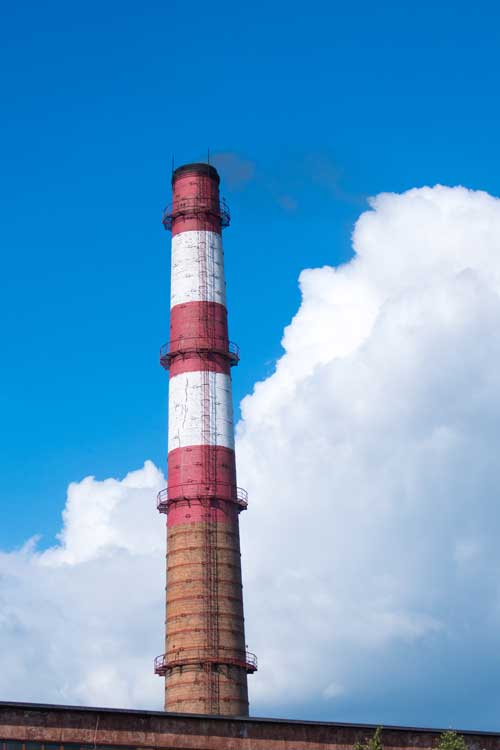SO2 - Sulfur Dioxide

Lime injection into exhaust gas helps absorb SO2 before release from tall stacks.
Sulfur dioxide (SO2) is one of a group of highly reactive gases known as oxides of sulfur. The largest source of emissions is fossil fuel combustion at power plants and other industrial facilities. Sulfur is a natural constituent of both petroleum and coal deposits. Smaller SO2 sources include industrial processes such as extracting metal from ore and the burning of high-sulfur fuels by locomotives, large ships, and non-road equipment.
Hydrogen sulfide (H2S) is a poisonous sulfur compound and present at high concentrations in “sour” petroleum wells. Burning sour gas converts the H2S into SO2. H2S can be removed from petroleum to meet low-sulfur fuel standards. Likewise, SO2 limits for coal-burning facilities created an incentive to mine low-sulfur coal.
Sulfur dioxide has a strong odor at high levels and is easily absorbed when we breathe. SO2 irritates the lungs, activates nerve reflexes, and causes injury to airway mucous membranes, which affects breathing. People with asthma can experience increased airway resistance when exercising under SO2 concentrations of less than 0.1 ppm (100 ppb).
SO2 is the major cause of acid rain because it dissolves in and acidifies atmospheric water. Acid rain damages buildings and statues by corroding minerals in limestone and marble. Acid rain also lowers the pH of (acidifies) forests, lakes, and streams, which harms aquatic wildlife.
There are two standards in place for sulfur dioxide: a primary 1-hour standard to protect human health, and a secondary 3-hour standard to protect the environment and property. Oklahoma is in attainment with both standards.
SO2 Monitoring Sites
The division monitors for sulfur dioxide at nine sites in the state. The monitors measure SO2 via pulsed fluorescence and report SO2 concentrations on an hourly basis. The values are then used to determine compliance with the standard. Current data may be accessed here.
2017 SO2 Data
Primary SO2 1-hour standard: 0.075 ppm (=75 ppb)
Secondary SO2 3-hour standard: 0.5 ppm
To attain the primary standard, the 3-year average of the 99th percentile of the daily maximum 1-hour average at each monitor within the area must not exceed 75 ppb. The secondary standard is not to be exceeded more than once per year.
2017 SO2 Values vs 1 Hour NAAQS
- OKC-North
- Tulsa-Peoria
- Tulsa-Riverside
- Tulsa-Water Dept
- Tulsa-NewBlock Park
- Pryor*
- Ponca City
- Ft. Gibson*
- Kremlin*
- Standard
- 2.7
- 5.6
- 6.3
- 11.7
- 14
- 25
- 29
- 52
- 54
- 75
- 0
3 yr avg ('15-'17) of 99th percentile
1 hr avg SO2 concentration (ppb)
*Does not have 3 years of data to compare against standard
2017 SO2 Values vs 3 Hour NAAQS
- OKC-North
- Tulsa-Riverside
- Tulsa-Peoria
- Tulsa-Water Dept
- Tulsa-NewBlock Park
- Pryor
- Ponca City
- Kremlin
- Ft. Gibson
- Standard
- 2
- 5
- 5
- 12
- 13
- 24
- 34
- 52
- 60
- 500
- 0
Arithmetic Mean of 3 hr avg SO2 concentration (ppb)